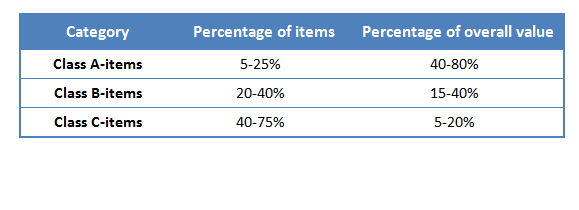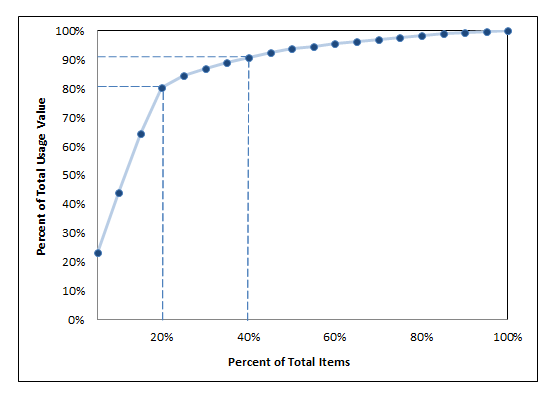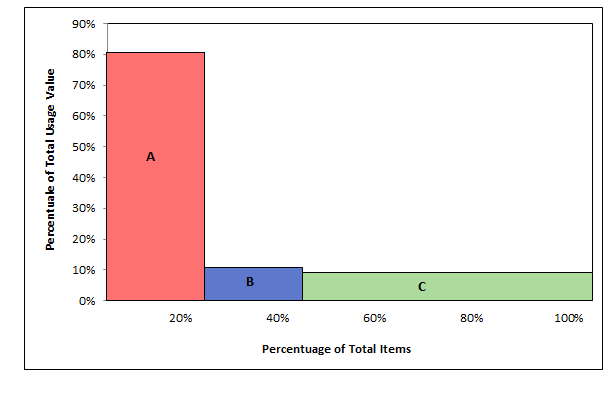
ABC Analysis

Introduction
ABC analysis is a method of classifying items, according
to their relative importance. This analysis aims to define
groups of items which have varying levels of significance
and must therefore be processed or controlled differently to each
other.
This
analysis is based on the Pareto principle (also known as
the 80–20 rule). It states that, for many events, roughly
80% of the effects come from 20% of the causes.
It is
frequently used in inventory management where it
is used to classify stock items into groups based on the total
annual expenditure for each item. Organizations can concentrate
more detailed attention on the high value/important
items.
ABC analysis categories
ABC
analysis requires that items (activities, customers, documents,
events, inventory items or sales territories, etc.) are categorized
into three groups based on their presumed significance. Three
categories (A, B, and C) can be defined as
follows:
-
A-items are especially important
-
B-items are of average importance
-
C-items are minimally important
There are no fixed threshold for each class, different
proportion can be applied based on objective and criteria.
According to the principle the A-items will typically
account for a large proportion of the overall value but a
small percentage of number of items. The following table shows
general rules for ABC analysis

ABC for Inventory Items
In a production system the number of items can be very high.
However, not all items have the same cost and are used in the same
quantities. The inventory items should be items that accounts for
the greatest value. In order to determine which items there are two
variables must considered: item demand and unit cost for each item.
To determine the usage value of an items, multiply the quantity
over a given period by unit cost.
Inventory items can be classified into these categories:
⦁ A-items are goods which usage value is highest
⦁ B-items are the interclass items, with a medium usage value
⦁ C-items are items with the lowest usage value
Therefore, those items that are the most demanded and most costly
are the most important inventory items. With only two data you can
rank all your inventory by importance; this classification is the
first step towards controlling independent demand
inventories.
The following procedure is one way of implementing an ABC
analysis:
1) Find out the unit cost and the quantity of each item over a
given period
2) Calculation of usage value of each item
3) List out all the items based on their usage value in decreasing
order
4) Calculation of the accumulated value
5) Classify items into A,B and C items groups
The percentage of the total items included in any class is quite
arbitrary, but the common values are given into previous table. A
typical curve, result of the ABC analysis, is given below

It has been observed that a small
percentage of the total number of items accounts for a large
proposition of total usage value. Three classes of items are
shown in following figure.

Inventory management policies
Policies based on ABC analysis leverage the sales imbalance
outlined by the Pareto principle. Each item should receive a
treatment corresponding to its class:
⦁ A-items should have
tight inventory
control, more secured storage areas and better sales
forecasts. Reorders should be frequent, with weekly or even daily
reorder; avoiding stock-outs on A-items is a priority.
⦁ B-items are an intermediate status between A and
C. An important aspect of class B is the
monitoring of potential evolution toward class A
or, in the contrary, toward the class
C.
⦁ C-items should be reordered less frequently. A
typically inventory policy for C-items consist of having only 1
unit on hand, and of reordering only when an actual purchase is
made. This approach leads to stock-out situation after each
purchase which can be an acceptable situation, as the C-items
present both low demand and higher risk of excessive inventory
costs.
Download here an ABC Analisys Exercise >

